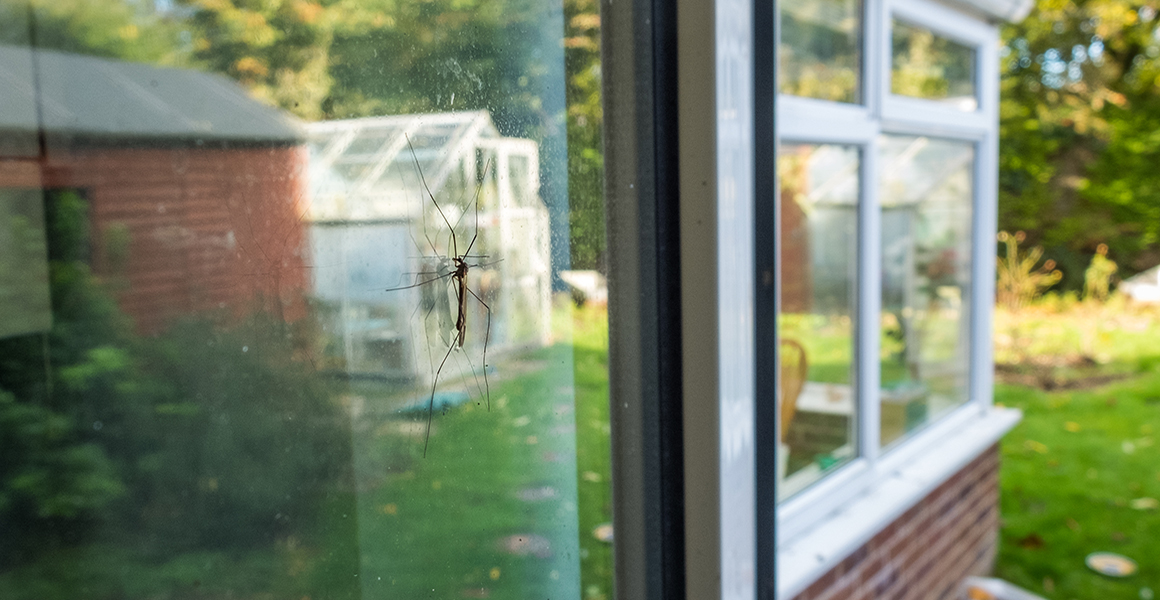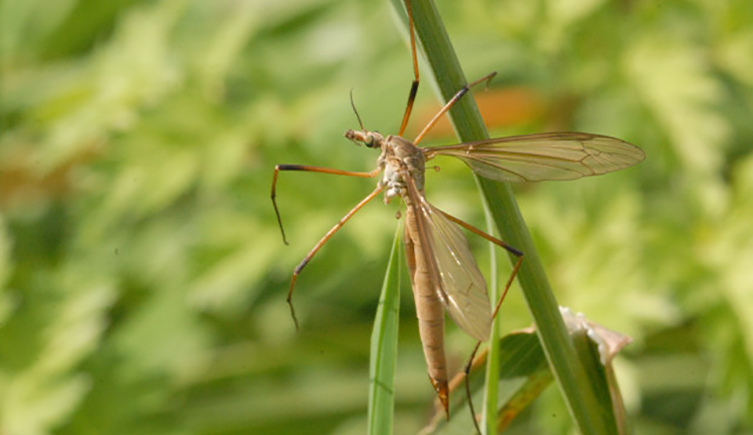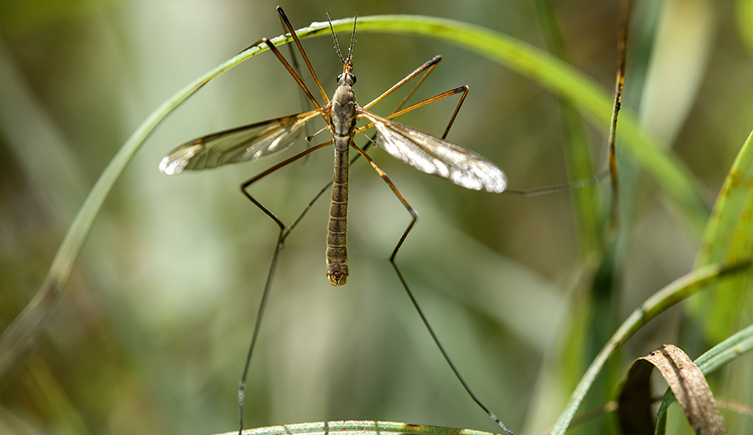Craneflies are long-legged flies that can be seen in spring and autumn. You might find some species in your house, as they are attracted to light at night.
Read on to find out if craneflies are harmful, how they survive their legs falling off and why at certain times of the year it seems as if they are absolutely everywhere.
What are craneflies?
Craneflies, also referred to as daddy long legs, have very long legs, thin wings and a thin body, which can make them look a bit like a giant mosquito. To tell them apart, look at the mouthpart, called a proboscis. If it doesn't have a long mouthpart, it's probably a harmless cranefly.
There are up to 350 cranefly species in the UK. Some of the larger species have bodies as big as five centimetres long, while other species are much smaller.
When is daddy long legs season?
The two species you are most likely to see in your house or garden are the meadow white-stripe cranefly or common European cranefly, Tipula paludosa, and the marsh cranefly, Tipula oleracea.
Tipula paludosa numbers peak in June and July in northern parts of the UK and on high ground. In the south they peak in September. Tipula oleracea numbers are highest in May and September.
How long do craneflies or daddy long legs live?
The adult cranefly is only alive for around two weeks and its main purpose is to mate and lay eggs.
Dr Erica McAlister, a fly expert at the Museum says, 'Most adults have a life span of 10-15 days but there is variation across the species. Some males mate with a female within seconds of her emerging, as her eggs matured before she left her pupal case [where the cranefly transformed into its adult form]. Other females need further time for their eggs to develop.'
Little is known about adult cranefly feeding habits. The cranefly larva probably eats enough so that the adult stage doesn't need to eat, but if the adults do feed, it's likely that they drink flower nectar.
Why do craneflies have such long legs?
Erica says, 'The long, dangly legs of the cranefly may seem ridiculous, but they offer many advantages. The legs add stability during flight, they act like whiskers sensing for hazards and they confuse predators. Long legs also enable the female to oviposit directly into the ground akin to some form of drill.'
So why do the flies lose their legs so readily?
Erica explains, 'Well, it's best to lose a leg rather than your life and often the predator is momentarily confused, offering the fly some vital seconds to fly off.'
Are craneflies or daddy long legs poisonous or venomous?
Craneflies cannot hurt you. It's a complete myth that craneflies have venom and they do not bite - unlike mosquitoes, gnats and midges, craneflies don't feed on blood and their mouthparts can't pierce human skin. They're not poisonous either.
The name daddy long legs can also refer to a spider and harvestmen, non-venomous relatives of spiders, which is why using common names for animals can sometimes get a little confusing.
Leatherjackets in your lawn
The adult cranefly lays its eggs in damp soil and these hatch into larvae. Some cranefly larvae, such as those of Tipula paludosa, are called leatherjackets.
Cranefly larvae live underground for much of the year and eat plant roots or decaying material in soil. The larvae thrive in damp soil, dead wood and around water. The larval stage is the longest life stage of a cranefly.
Leatherjacket larvae provide feasts for hedgehogs, foxes, badgers and birds such as starlings. If you spot your lawn being dug up by these animals, this could be why - although they could also be hunting for beetle larvae.
What are craneflies good for?
Craneflies are an important food source for birds and bats, which can rely on them to survive. This is probably why craneflies don't tend to emerge in the middle of summer, as they are trying to avoid being eaten before they can mate.
Craneflies are very good indicators of habitat health - if you find lots of cranefly species in an area, it's a good indication that it is a diverse and quality habitat.
If you want to help scientists understand craneflies in the UK, you can get involved in the cranefly recording scheme.
A beginner's guide to British cranefly species
Scientists split craneflies into four groups:
- long-palped craneflies - these are large ones such as Tipula paludosa
- short-palped craneflies - these are small ones
- hairy-eyed craneflies - hairy eyes are unique to this group of craneflies, no other flies have them
- slender-bodied craneflies - also called damsel craneflies
A small group called false craneflies or phantom craneflies is sometimes grouped with craneflies, but they are quite distinctive. Sometimes winter gnats are also included in cranefly keys - a key is an identification tool.
You can tell the difference between male and female craneflies by their body shape. The abdomen of a female cranefly ends in a point - the ovipositor, which it uses to lay eggs. Males have a blunt abdomen.
Dr Duncan Sivell, a fly curator at the Museum says, 'If you see a small cloud of around 20-30 flies in park or garden in spring to autumn, they're probably a short-palped cranefly species.'
'If you see a small cloud of dancing flies and it's not summer, they are probably winter gnats because they can still fly when it's as cold as six degrees Celsius.'
The cranefly collection at the Museum holds species that haven't been identified yet and there are possibly still cranefly species in the UK that are new to science. You could be the one to find them.





Don't miss a thing
Receive email updates about our news, science, exhibitions, events, products, services and fundraising activities. We may occasionally include third-party content from our corporate partners and other museums. We will not share your personal details with these third parties. You must be over the age of 13. Privacy notice.
Follow us on social media